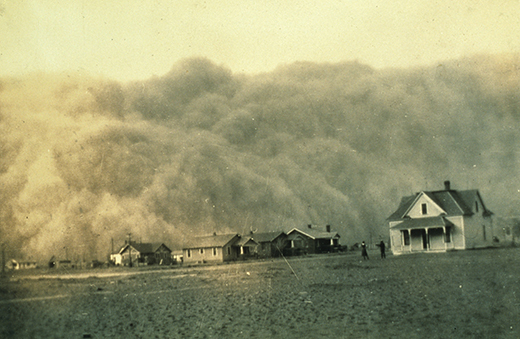| << Chapter < Page | Chapter >> Page > |
Exacerbating the problem was a massive drought that began in 1931 and lasted for eight terrible years. Dust storms roiled through the Great Plains, creating huge, choking clouds that piled up in doorways and filtered into homes through closed windows. Even more quickly than it had boomed, the land of agricultural opportunity went bust, due to widespread overproduction and overuse of the land, as well as to the harsh weather conditions that followed, resulting in the creation of the Dust Bowl ( [link] ).

Livestock died, or had to be sold, as there was no money for feed. Crops intended to feed the family withered and died in the drought. Terrifying dust storms became more and more frequent, as “black blizzards” of dirt blew across the landscape and created a new illness known as “dust pneumonia.” In 1935 alone, over 850 million tons of topsoil blew away. To put this number in perspective, geologists estimate that it takes the earth five hundred years to naturally regenerate one inch of topsoil; yet, just one significant dust storm could destroy a similar amount. In their desperation to get more from the land, farmers had stripped it of the delicate balance that kept it healthy. Unaware of the consequences, they had moved away from such traditional practices as crop rotation and allowing land to regain its strength by permitting it to lie fallow between plantings, working the land to death.
For farmers, the results were catastrophic. Unlike most factory workers in the cities, in most cases, farmers lost their homes when they lost their livelihood. Most farms and ranches were originally mortgaged to small country banks that understood the dynamics of farming, but as these banks failed, they often sold rural mortgages to larger eastern banks that were less concerned with the specifics of farm life. With the effects of the drought and low commodity prices, farmers could not pay their local banks, which in turn lacked funds to pay the large urban banks. Ultimately, the large banks foreclosed on the farms, often swallowing up the small country banks in the process. It is worth noting that of the five thousand banks that closed between 1930 and 1932, over 75 percent were country banks in locations with populations under 2,500. Given this dynamic, it is easy to see why farmers in the Great Plains remained wary of big city bankers.
For farmers who survived the initial crash, the situation worsened, particularly in the Great Plains where years of overproduction and rapidly declining commodity prices took their toll. Prices continued to decline, and as farmers tried to stay afloat, they produced still more crops, which drove prices even lower. Farms failed at an astounding rate, and farmers sold out at rock-bottom prices. One farm in Shelby, Nebraska was mortgaged at $4,100 and sold for $49.50. One-fourth of the entire state of Mississippi was auctioned off in a single day at a foreclosure auction in April 1932.

Notification Switch
Would you like to follow the 'U.s. history' conversation and receive update notifications?